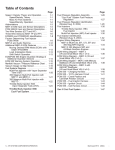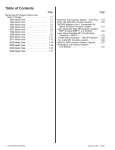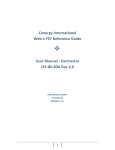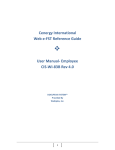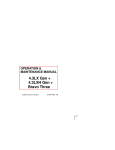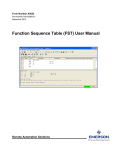Download Electric Fuel Pump Troubleshooting
Transcript
Service Bulletin Warranty Information Service Information Bulletin No. 2004-01 Parts Information Circulate to: Sales Manager Accounting Service Manager Technician Parts Manager Electric Fuel Pump Troubleshooting Models Affected All MerCruiser V6 and V8 carburetor, EFI and MPI gas engines. Situation Mercury MerCruiser receives electric fuel pumps returned for warranty that function properly when tested (No Trouble Found). Engines that are not run for extended periods of time or are placed in storage with untreated fuel are at risk of forming fuel gum. The accumulation of fuel gum can seize electric fuel pumps, which typically results in the replacement of a mechanically sound fuel pump. NOTE: Boost pumps used on EFI or MPI models are the same low pressure pump used on carbureted models. The pumps used to pressurize the EFI or MPI system is a high pressure pump. IMPORTANT: Electric fuel pump can be run dry for 10 seconds. Do not run the pump dry repeatedly or internal damage may occur. A lot can be learned by putting your hand on the fuel pump when voltage is applied to the pump. 1. If the pump does not run but feels like a solenoid closing when battery voltage is applied, it is locked up. In most cases, the pump is locked up because of fuel gum and can be freed by doing the following. a. Leave the pump full of a mixture of fresh gasoline and Fuel System Treatment and Stabilizer overnight. b. Use mixture as outlined in the fogging procedure in MerCruiser Service Bulletin 2001-15. IMPORTANT: Do not use the FSTS concentrate when doing this. Other fuel system components that may be gummed up should be treated with this same mixture. c. Use 29 ml (1 fl. oz.) of the FSTS per 3.7 L (1 US gal) of fuel for the next 75.7 L (20 US gal) of fuel used in the engine. THE INFORMATION IN THIS DOCUMENT IS CONFIDENTIAL AND PROTECTED BY COPYRIGHT AND IS THE PROPERTY OF MERCURY MARINE. This document is provided for the sole and exclusive use of the original recipient as prescribed by Mercury Marine and may not be distributed or copied, digitally or otherwise, without the prior written consent of Mercury Marine. 2004-01R JANUARY 2004 © 2003, Mercury Marine Page 1 / 2 ELECTRIC FUEL PUMP TROUBLESHOOTING NOTE: On low pressure boost or carburetor fuel pumps, plugging the outlet, and then running the pump against this blockage for a short time can loosen the stuck internal check valve. 2. If the pump runs but feels like a rough ball bearing when battery voltage is applied, it more than likely has an internal problem and needs to be replaced. A normal pump running will not feel "rough". The low pressure pump has less vibration to it than the high pressure pump. 3. If the pump does not run at all when battery voltage is applied, check for battery voltage at the pump. Check the following. NOTE: Use the wiring diagrams, pressure gauge connections and observe all Warnings and Cautions as outlined in the Service Manual for the engine being worked on. Items listed below may not apply to the engine that you are working on. • Ignition key, cannon plug connector corrosion, loose connection at 50A circuit breaker, blown fuse, etc. • Check fuel pump electric harness connector. The pump needs good positive and ground connection. • Fuel pump relay (EFI or MPI models). • Oil pressure switch (carb models). 4. If the pump runs when battery voltage is applied, check fuel pump pressure. Connect a service test fuel gauge to the location outlined in the Service Manual. On MPI engine, a Schrader valve is provided for this purpose. On EFI (TBI) models and carbureted models, a test Tee-fitting is required to connect the test gauge. Compare pressure reading to the specifications listed in the Service Manual. If the pressure is higher than specifications: • The pump’s internal check valve may be stuck from fuel gum. • A defective fuel pressure regulator (EFI or MPI models). • Check for a pinched or plugged hose going to fuel pressure regulator (EFI or MPI models). If the pressure is lower than specifications: • Low battery voltage to the pump. • Fuel tank pickup, fuel tank vent hose, fuel filter or fuel line restriction. • Faulty anti-siphon valve. • Air leak somewhere in boat’s fuel line. • Vapor locking. • Faulty fuel pressure regulator (EFI or MPI models). NOTE: Refer to MerCruiser Service Bulletins 1998-04, 1998-05, 1999-07, 1999-08 and 2001-04 for additional information concerning electric fuel pumps. Warranty Any electric fuel pumps returned to Mercury MerCruiser for warranty and found to function properly (No Trouble Found) may be subject to claim denial and parts returned to the dealer. THE INFORMATION IN THIS DOCUMENT IS CONFIDENTIAL AND PROTECTED BY COPYRIGHT AND IS THE PROPERTY OF MERCURY MARINE. This document is provided for the sole and exclusive use of the original recipient as prescribed by Mercury Marine and may not be distributed or copied, digitally or otherwise, without the prior written consent of Mercury Marine. Page 2 / 2 © 2003, Mercury Marine JANUARY 2004 2004-01R


